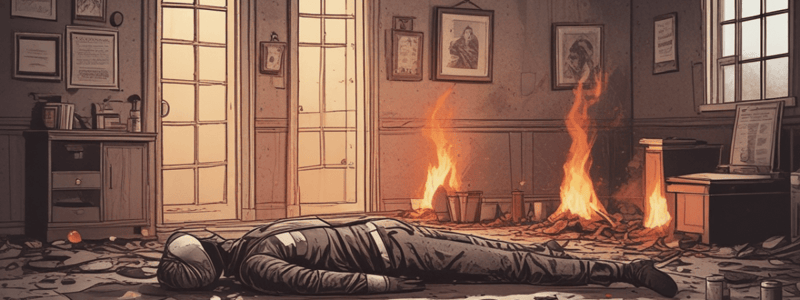Podcast
Questions and Answers
What is the primary mode of heat transfer in conduction?
What is the primary mode of heat transfer in conduction?
- Through direct contact between objects (correct)
- Through electromagnetic waves
- Through combustion reactions
- Through circulating mediums
During which phase of a structural fire do flames start to produce a large amount of dark gray smoke?
During which phase of a structural fire do flames start to produce a large amount of dark gray smoke?
- Free burning/flame producing phase (correct)
- Smoldering phase
- Incipient phase
- Extinguishing phase
What is the typical ceiling temperature during the incipient phase of a structural fire?
What is the typical ceiling temperature during the incipient phase of a structural fire?
- 1000 degrees Fahrenheit
- 100 degrees Fahrenheit (correct)
- 1300-1600 degrees Fahrenheit
- 100 degrees Celsius
What is a potential hazard during the smoldering phase of a structural fire?
What is a potential hazard during the smoldering phase of a structural fire?
What is the primary characteristic of the smoldering phase of a structural fire?
What is the primary characteristic of the smoldering phase of a structural fire?
During which phase of a structural fire is human survival impossible?
During which phase of a structural fire is human survival impossible?
What is the minimum number of people whose death or serious physical injury can be caused by an act, which is considered a felony?
What is the minimum number of people whose death or serious physical injury can be caused by an act, which is considered a felony?
What is the classification of the felony for knowingly possessing, manufacturing, transporting, repairing, or selling an explosive weapon?
What is the classification of the felony for knowingly possessing, manufacturing, transporting, repairing, or selling an explosive weapon?
What is the classification of the felony for bombing or planting a bomb or other explosive matter upon or near any terminal or bus?
What is the classification of the felony for bombing or planting a bomb or other explosive matter upon or near any terminal or bus?
What is the classification of the offense for making a false report of a bomb or other explosive in a public or private place or vehicle?
What is the classification of the offense for making a false report of a bomb or other explosive in a public or private place or vehicle?
What is the primary reason for turning off the radio when nearing a bomb threat scene?
What is the primary reason for turning off the radio when nearing a bomb threat scene?
Who is responsible for deciding whether to evacuate a building during a bomb threat?
Who is responsible for deciding whether to evacuate a building during a bomb threat?
What is the primary purpose of conducting a building search during a bomb threat?
What is the primary purpose of conducting a building search during a bomb threat?
What is the general rule for establishing a perimeter during a bomb threat response?
What is the general rule for establishing a perimeter during a bomb threat response?
What is the key element required for a fire to occur?
What is the key element required for a fire to occur?
What is the result of rapid oxidation during a fire?
What is the result of rapid oxidation during a fire?
What is the primary objective of a criminal investigation?
What is the primary objective of a criminal investigation?
What type of bomb causes damage by fragmentation, heat, and blast wave?
What type of bomb causes damage by fragmentation, heat, and blast wave?
What is the penalty for knowingly damaging a building or inhabitable structure by starting a fire or causing an explosion?
What is the penalty for knowingly damaging a building or inhabitable structure by starting a fire or causing an explosion?
Who should conduct a search of a facility for a device after a bomb threat?
Who should conduct a search of a facility for a device after a bomb threat?
What is the penalty for recklessly damaging or destroying a building or inhabitable structure of another by knowingly starting a fire or causing an explosion?
What is the penalty for recklessly damaging or destroying a building or inhabitable structure of another by knowingly starting a fire or causing an explosion?
What is the penalty for knowingly burning or exploding property of another?
What is the penalty for knowingly burning or exploding property of another?
What is the term for damaging property of another by starting a fire or causing an explosion with criminal negligence?
What is the term for damaging property of another by starting a fire or causing an explosion with criminal negligence?
What is the penalty for causing damage to property of another by fire or explosion with criminal negligence?
What is the penalty for causing damage to property of another by fire or explosion with criminal negligence?
Flashcards are hidden until you start studying
Study Notes
Objectives of a Criminal Investigation
- List the basic types of bombs
- Identify statutes pertaining to arson and explosives
- Identify the patrol officer's role in responding to a bomb threat
- State who should conduct a search of a facility for a device after a bomb threat
Types of Bombs
- Explosive Bomb: a device that causes damage by fragmentation, heat, and blast wave, often producing a fire
- Incendiary Bomb: a device constructed with flammable materials designed to produce a burning effect
Laws Pertaining to Arson and Explosives
- Arson (Class A, B, or C Felony): knowingly damaging a building or inhabitable structure by starting a fire or causing an explosion
- Knowingly burning or exploding (Class "D" Felony): knowingly damaging property of another by starting a fire or causing an explosion
- Reckless burning or exploding (Class "A" Misdemeanor): recklessly damaging or destroying a building or inhabitable structure of another by knowingly starting a fire or causing an explosion
- Negligent burning or exploding (Class "B" Misdemeanor): with criminal negligence causing damage to property of another by fire or explosion
- Causing catastrophe (Class "A" Felony): knowingly causing death or serious physical injury to ten or more people, or substantial damage to five or more buildings or inhabitable structures
- Possession, manufacture, transport, repair, or sale of certain weapons prohibited (Class "C" Felony): knowingly possessing, manufacturing, transporting, repairing, or selling an explosive
- Bombing and other explosive matter upon bus or near bus terminal (Class "A" Felony): to bomb or to plant or place any bomb or other explosive matter upon or near any terminal or bus
- False Bomb Report (Class "A" Misdemeanor): knowingly making or causing to be made a false report to any person that a bomb or other explosive has been placed in a public or private place or vehicle
Bomb Threat Response Procedures
- Turn radio off when nearing scene to avoid detonating an explosive device
- Contact manager/person in charge to inform them of the situation and let them decide whether to evacuate the building
- Building search should be conducted by personnel who are most familiar with the premises
- Evacuation should be done if an explosive device or suspected device is found
- Evacuate everyone, be aware of the possibility of a second device, and post guards at entrances
- Evacuation distances depend on the size of the explosive device
- Secure a perimeter of 300 feet for unknown sized devices
Bombing Scene Procedures
- Establish a perimeter by locating the furthest piece of debris from the blast seat and measuring the distance from that debris to the blast seat
- Limit admittance to scene to paramedics, arson and explosive detectives, and crime scene technicians
- Use one entry/exit path to minimize the chance of destroying fragile evidence
- Be cautious and aware of secondary devices while securing the perimeter
Elementary Chemistry of Fire
- Burning requires four elements: heat, oxygen, fuel, and uninhibited chain reaction
- Heat is transferred through conduction, convection, and radiation
- Phases of structural fires include:
- Incipient (first phase): fire produces gases, rapid progress after flaming starts
- Free burning/flame producing (second phase): major involvement, convection heating, large amount of dark gray smoke
- Smoldering (third phase): burning is reduced to glowing embers, large quantity of toxic/flammable gases, back draft possibility
Studying That Suits You
Use AI to generate personalized quizzes and flashcards to suit your learning preferences.




